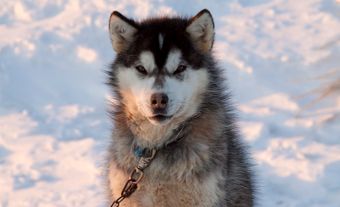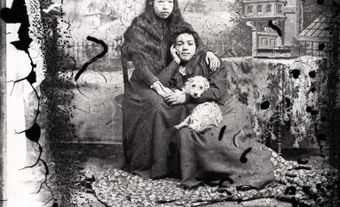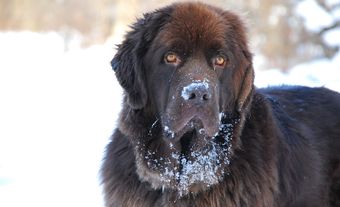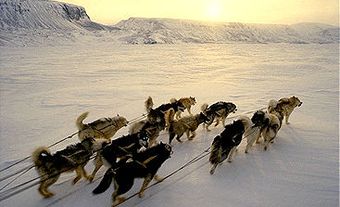The Tahltan (pronounced tall-tan) bear dog was one of five dog breeds recognized by the Canadian Kennel Club as uniquely Canadian (see also Dogs in Canada). Although the name of the breed suggests it was only kept by the Tahltan Nation of Northwestern British Columbia, the dog was common among other First Nations in the region, too. These included the Tlingit, Tagish, Kaska and Sekani. The Tahltan people referred to it as “our dog,” which gave the breed its name. Indigenous peoples used the Tahltan bear dog in sustenance hunting— primarily for bear— an activity in which it excelled. The breed went extinct in the in the 1970s or 80s.
Appearance

The Tahltan bear dog was small, measuring 30 to 40.5 cm and weighing 4.5 to 8 kg — about the size of a fox terrier. The breed was typically black and white, with pricked-up ears, a sharp nose and a short, upright tail resembling a shaving brush. Its mid-length coat was dense, with a longer ruff around the neck.
Origins and Breeding History
According to Tahltan oral history, the bear dog was present among the Tahltan people since time immemorial. Legends describe how it was created by magic to protect Indigenous peoples living in what now is Northwestern British Columbia.
Explorer Samuel Black documented the Tahltan bear dog in 1824 — the first written records of the breed. In the early 1900s, ethnographer James Teit also documented the dog, during his studies of Tahltan culture.
The Canadian Kennel Club (CKC) recognized the Tahltan bear dog as a distinct breed in 1941. The efforts made by BC police officer J.B. Grey, posted to Telegraph Creek in the late 1930s, greatly contributed to this recognition.
Did you know?
Of the five Canadian dog breeds, one is extinct: the Tahltan bear dog. The remaining four breeds are the Canadian Inuit dog, the Nova Scotia duck tolling retriever, the Newfoundland dog and the Labrador retriever. Another domestic dog, the Salish woolly dog, went extinct around 1900. It had significantly declined before the Canadian Kennel Club could afford it recognition as an official breed.
The Tahltan bear dog was widely traded, resulting in a number of crossbred dogs. In addition, white people arriving on Tahltan territory introduced a variety of dogs to the area, and the breed became increasingly mixed. In 1969, the Tahltan bear dog was still present in slim numbers in Telegraph Creek, Iskut and Atlin in BC, and in Carcross, Whitehorse and Keno in Yukon.
Various factors led to the demise of the dog, including modern firearms, illnesses and people neglecting to breed it. The last registration of a Tahltan bear dog with the CKC was in 1953. While no official date exists, the breed went extinct sometime in the 1970s or 80s.
Temperament and Traits
Tahltan bear dog owners valued the breed’s bravery, agility, intelligence and tenacity. The dogs were often bred for specific abilities, including hunting certain prey.
Although fearless, the Tahltan dog didn’t do well when removed from its northern habitat. According to testimonies from members of the Tahltan Nation, the dogs died or became ill once away from their native land. The reasons for this remain unclear, but may have included the change in diet and climate, and exposure to new diseases.

Hunting
The Indigenous peoples of Northwestern British Columbia used the Tahltan bear dog for sustenance hunting. Although small, they were feisty and excelled in hunting big game. As their name suggests, they were primarily known for hunting bears. However, they also hunted other animals, including moose, rabbit, porcupine, lynx, grouse and ptarmigan. The Tahltan dog barked relentlessly during hunting to signal where the prey was located. Its bark had different pitches for different kinds of animals.
Hunters often carried the dogs on their backs in a sack before releasing them, to preserve their energy. Two or three dogs were used in bear hunting, which took place in winter or spring. At this time of year, because of their small size, Tahltan dogs could run on top of the hard snow while the bears sunk and struggled. One dog ran ahead of the bear while the other harassed it from behind, trapping the bear until the hunter arrived.

Role in Local Indigenous Economy
Tahltan bear dogs were highly valued by Indigenous peoples of Northwestern British Columbia and Southern Yukon. Ethnographer James Teit states that they were “as indispensable to the Tahltan as snowshoes.” When interviewed by researcher Leslie Kopas, Tahltan elder John Carlick put it this way: “If you had a bear dog you could find game. If you didn’t have a bear dog, you starved.” Unlike other working dogs, owners revered the Tahltan dogs, making shelters for them and even welcoming them into their tents.
The Tahltan dog’s bravery is celebrated in the region’s mythology. Local stories tell of the dog’s role in sustenance hunting, and portray the close-knit relationships between humans and dogs.
Factors Leading to Extinction
When traders introduced firearms to Northwestern British Columbia, the role of the Tahltan bear dog in the livelihood of the region’s Indigenous peoples greatly diminished. Hunters were able to shoot big game without the assistance of dogs. Sled dogs became more important than bear dogs in hunting activities. Sled dogs also killed bear dogs when they caught them.
In addition to firearms, other factors contributed to the eventual extinction of the Tahltan bear dog. A number of them died in the late 1940s during a distemper outbreak. In 1942, an epidemic of flu and measles in Telegraph Creek killed many elders who owned bear dogs. Following the epidemic, many Tahltan dogs were shot because they were running loose. The arrival of the snowmobile also contributed to the demise of the bear dog. Last but not least, the small number of Tahltan bear dogs still present in the late 1960s stopped being bred.

 Share on Facebook
Share on Facebook Share on X
Share on X Share by Email
Share by Email Share on Google Classroom
Share on Google Classroom





